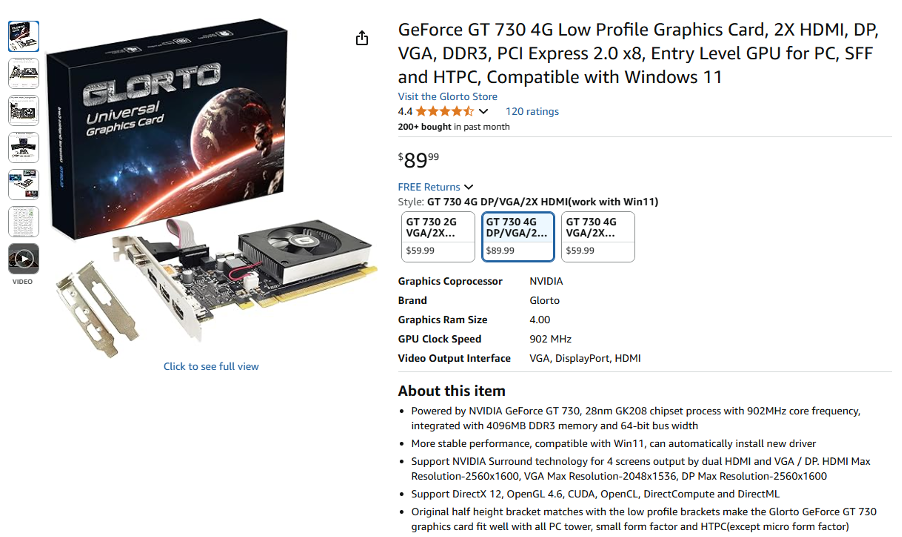
Choosing a second-hand graphics card (GPU) requires balancing cost, performance, and risk. Below is a structured guide to help you make an informed decision:
1. Define Your Needs & Budget
Start by clarifying your primary use case and budget to narrow down options:
- Gaming: For 1080P high-quality gaming, mid-range GPUs like the RTX 3060, RX 6650 XT, or RTX 4060 are ideal. For 2K/4K or ray tracing, consider higher-end models like the RTX 4070 or RX 7800 XT (but expect higher prices).
- Content Creation (Design/Rendering): Prioritize GPUs with strong CUDA cores (NVIDIA) or RDNA2/3 architecture (AMD) for acceleration in tools like Blender, Premiere Pro, or Photoshop. Models like the RTX 4070 Ti, RTX 3090, or RX 7900 XT are good fits.
- Budget: Set a clear limit. Used GPUs often cost 30%-60% less than new ones, but avoid overspending on outdated models (e.g., GTX 1080 Ti) unless they’re drastically cheaper.
2. Avoid "Mine-Used" GPUs (Critical!)
Mining GPUs endure 24/7 high loads, accelerating wear and reducing lifespan. Follow these steps to spot them:
- Check Power-On Hours (POH): Use tools like GPU-Z or HWInfo. Most consumer GPUs have POH under 2,000–3,000 hours. Mine-used GPUs often exceed 5,000+ hours.
- Inspect Physical Condition:
- Cooling System: Mine cards have heavily dusted heatsinks/fans (may contain "mine dust"). Check for swollen/burst capacitors (top/bottom of the GPU die).
- Gold Fingers: Overheating causes oxidation—blackened or corroded gold fingers (where the GPU plugs into the motherboard) signal heavy use.
- Backplate/Stickers: Mine farms sometimes cover serial numbers (SN) with stickers or labels. Ask the seller to remove them for verification.
- Ask About Usage History: If the seller claims "home use" but can’t provide details (e.g., "used for 2 years, 8 hours/day"), treat it as suspicious.
3. Select a Reliable Model
Focus on GPUs with strong resale value and low mine risk. Here’s a tiered list (as of 2024):
| Use Case | Recommended Models | Key Notes |
| 1080P Gaming | RTX 3060, RX 6650 XT, RTX 4060 | Balanced price/performance; low mine risk. |
| 2K Gaming/Ray Tracing | RTX 4070, RX 7800 XT, RTX 3070 | Newer architectures (Ada Lovelace/RDNA3) reduce mine prevalence. |
| Productivity | RTX 4070 Ti, RTX 3090, RX 7900 XT | High CUDA/RDNA cores for rendering/AI tasks. |
| Avoid | GTX 1080 Ti, RTX 2080 Ti, older AMD Vega cards | High power draw, frequent mine use, outdated tech. |
4. Inspect & Test the GPU (If Possible)
Even if the seller claims it’s "tested," verify it yourself:
- Software Tests:
- Run FurMark (stress test) for 30+ minutes. Watch for artifacts (glitches, lines, black screens) or throttling (clock speeds dropping).
- Use 3DMark Time Spy/Port Royal to benchmark performance against baseline specs (check TechPowerUp for reference).
- Hardware Checks:
- Disassemble the GPU (if comfortable) to check for:
- Swollen capacitors (indicates overheating).
- Dust-clogged heatsinks/fans (clean them if buying, but factor in labor cost).
- Loose/bent PCIe pins (will cause connectivity issues).
5. Verify Seller & Warranty
- Seller Reputation: Buy from trusted platforms (e.g., eBay with buyer protection, specialized PC part marketplaces) or local sellers with reviews. Avoid anonymous sellers with no feedback.
- Warranty Offered: Reputable sellers provide 1–3 months of store warranty. Confirm what’s covered (e.g., core failures, fan issues) and exclusions (e.g., physical damage, normal wear).
- Return Policy: Ensure you can return the GPU within 48–72 hours if it fails initial tests (ask for a written policy).
6. Compatibility Check
Ensure the GPU fits your system:
- Power Supply (PSU): Match the GPU’s power requirement (e.g., RTX 4060 needs ~160W; pair with a 500W+ PSU with an 8-pin PCIe cable).
- Motherboard Slot: Confirm your motherboard has an available PCIe x16 slot (most modern boards do).
- Case Space: Check GPU length (e.g., RTX 4070 Ti is ~30cm long; ensure your case can fit it).
Final Tips
- Price Comparison: Use platforms like eBay, Craigslist, or Facebook Marketplace to compare similar models. If a deal seems "too good," it likely is (mine card risk).
- Ask for Photos/Video: Request unboxing videos, close-ups of the GPU, and stress test footage to confirm condition.
By following these steps, you’ll minimize risks and maximize the value of your second-hand GPU purchase.